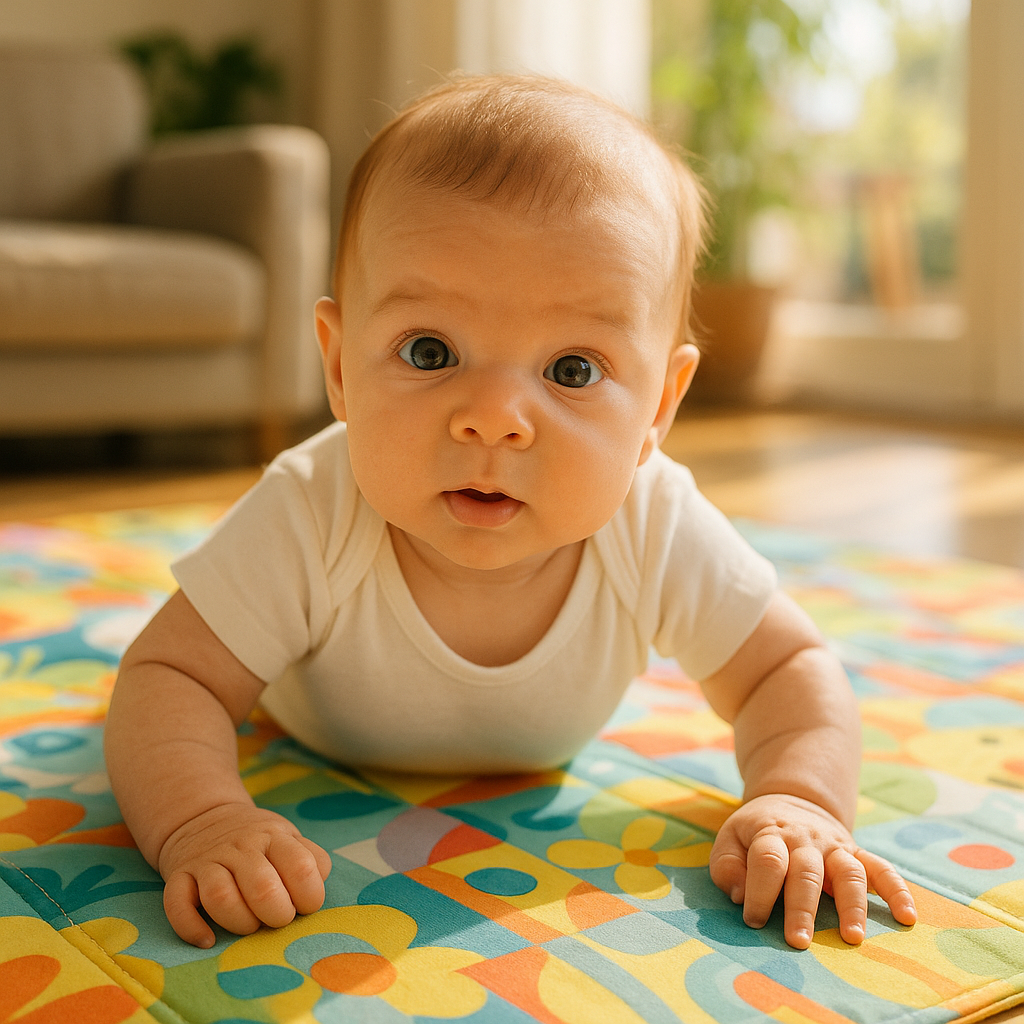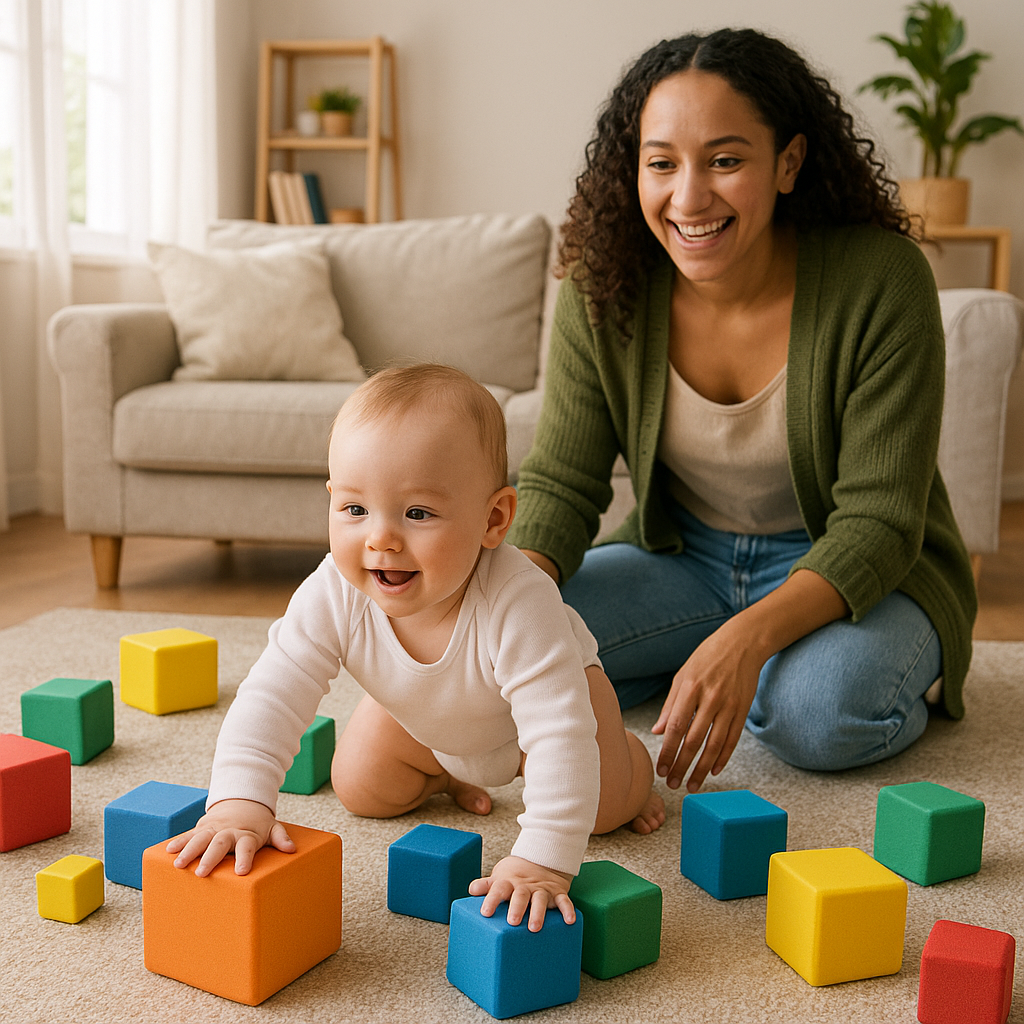Imagine your baby’s first crawl sparking millions of new neural connections in a single afternoon. Every roll, sit-up, or wobbly step isn’t just adorable—it is literally sculpting the brain pathways that power focus, memory, and problem-solving for years to come. Discover more on: First Things First – Early Brain Growth.
- What are gross motor milestones and how do they fuel brain growth?
- How does movement literally rewire an infant’s brain?
- When do most babies reach each gross motor milestone?
- Which parent-led activities safely encourage each milestone?
- How do gross and fine motor skills work together for learning?
- My baby seems delayed—should I worry or act now?
- What everyday factors boost—or block—motor and brain growth?
- Your top questions, answered
- Why every wiggle counts today and tomorrow
What are gross motor milestones and how do they fuel brain growth?
Gross motor milestones are the big-muscle movements—rolling, sitting, crawling, walking—that follow a head-to-toe, core-to-limb pattern called “proximal-to-distal.”
When your baby practices these skills, the motor cortex, cerebellum, and sensory pathways fire in rapid sequence, strengthening synapses and speeding white-matter myelination. NIH imaging shows a measurable jump in somato-motor-default mode network connectivity within two weeks of first independent steps.
Curious about the wider impact of movement? Visit How Physical Activity Boosts Your Baby’s Brain.

How does movement literally rewire an infant’s brain?
Mirror neurons activate both when babies move and when they watch you move, accelerating motor learning and budding empathy. Crawling weaves vestibular, visual, and proprioceptive input into a single sensory “map,” laying the groundwork for spatial awareness and later reading readiness. See Harvard Center on the Developing Child – Brain Architecture.
Quick proof: A 2024 Oregon State study found toddlers with top-quartile gross-motor scores outperformed peers on inhibition tasks by about 20 %. Repetition plus exploration equals neuroplasticity, executive function, and stronger attention spans.
Want to boost small-muscle precision too? Pair these gains with Fine Motor Skills: Boosting Your Baby’s Brain Power.
When do most babies reach each gross motor milestone?
Below is a guide—not a stopwatch. Small variations are normal.
| Skill | Typical age range | Brain benefit snapshot |
|---|---|---|
| Roll over | 4–6 months | Builds core strength, primes bilateral coordination |
| Sit unsupported | 6–8 months | Frees hands for object exploration, boosting hand-eye circuits |
| Crawl | 7–10 months | Cross-body pattern strengthens corpus callosum. See Pathways.org – How Crawling Helps Development |
| Pull to stand | 9–12 months | Enhances vestibular system and balance centers |
| Walk | 12–15 months | Expands default mode–attention network connectivity |
Tip: Download the CDC milestone checklist PDF for fridge-door reference at CDC developmental milestone checklist . Infants in belly-carry cultures often walk later yet show superior balance—proof development is flexible.
Red flag: Not sitting by 9 months or not walking by 18 months deserves a pediatric check. Compare brain perks of crawling in Gross Motor Skills: How Crawling Boosts Baby’s Brain.
Which parent-led activities safely encourage each milestone?
A few targeted play ideas go a long way:
0–3 months
• Tummy time in 3-minute bursts, several times daily in NIH guidelines on tummy time.
• Chest-to-chest “kangaroo” holds that rock gently, stimulating the vestibular system.
4–6 months
• Supported sitting with textured toys to prompt trunk control.
• Side-lying play so baby can practice rolling both ways.
7–10 months
• Low pillow obstacle course.
• “Circle baby with toys” to motivate pivoting, reaching, and crawling.
10–15 months
• Push toys and cruising along furniture for balance.
• Floor play in bare feet—skip prolonged use of walkers, which can delay hip muscle activation.
Find step-by-step demos in 5 Baby Exercises to Boost Brain Development.

How do gross and fine motor skills work together for learning?
Core stability from gross-motor practice lets your child master the pincer grasp, scribble, and later, write legibly. Crawling, which crosses the body’s midline, thickens the corpus callosum, improving bilateral coordination needed for reading and typing. Healthy hearing and vision speed this integration—explore more in Hearing and Vision: Why They’re Key for Baby’s Learning.
My baby seems delayed—should I worry or act now?
Act early rather than wait. Track what you see for two weeks, then compare to typical ranges. Evidence shows therapy begun before age 2 doubles the odds of catching up. Tools like the ASQ-3 questionnaire or the free CDC Milestone Tracker app make monitoring simple. Remember, 1 in 7 kids walks after 15 months and develops typically—steady progress matters more than exact dates. Parents of preemies can check adjusted timelines in Premature Baby Brain: Helping Your Preemie Thrive.
What everyday factors boost—or block—motor and brain growth?
• Floor time beats “container culture.” Prolonged swings/bouncers weaken hip-extensor strength.
• Iron and DHA-rich foods bolster myelination during rapid motor spurts—see Baby Gut Health: How It Supports Brain Development.
• Well-timed naps leave babies energized for active play.
• Keep recreational screen time under 1 hour/day; sedentary minutes displace exploration.
• An enriched environment—safe space, varied textures, caregiver encouragement—supercharges sensory diets and neural scaffolding.
Your top questions, answered
-
How can I speed up walking?
Barefoot floor time and sturdy push toys encourage balance; avoid rigid walkers. Muscles strengthen faster when feet can grip and toes can flex. -
Is skipping crawling harmful?
Usually no, but crawling offers unique brain benefits. Encourage the pattern through tunnel play even after walking starts to reap cross-body gains. -
How much tummy time is enough?
Aim for 20–30 total minutes daily by 3 months, split into short sessions. Increase gradually as your baby tolerates it. -
Do vaccines affect motor milestones?
No—scientific studies show no link. Learn more in Vaccines and Baby Brain: Debunking Autism Myths. -
Which red flags require urgent help?
Loss of a previously gained skill, extreme stiffness or floppiness, or using only one side of the body warrant immediate pediatric evaluation.
Why every wiggle counts today and tomorrow
Each roll, scoot, and stumble forges neural highways your child will use to read, reason, and relate to others. By clearing safe spaces, cheering on attempts, and seeking help when needed, you become the architect of both movement and mind. Download our printable milestone tracker and explore more ideas in How Physical Activity Boosts Your Baby’s Brain. Let the brain-building begin!